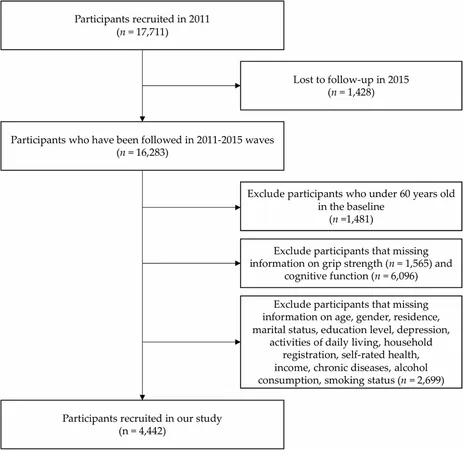
The Surprising Link Between Grip Strength and Cognitive Function in Older Chinese Adults
2025-05-22
Author: Yu
Population Aging: A Looming Crisis in China
As China faces a staggering increase in its aging population, a study highlights the risks associated with this demographic shift. By 2021, over 264 million individuals aged 60 and older made up 18.7% of the total Chinese population. The implications of this phenomenon on public health are profound, particularly concerning age-related chronic diseases.
The Dual Threat: Declining Grip Strength and Cognitive Function
Cognitive function is essential for maintaining a good quality of life in older adults, but it tends to decline with age. Interestingly, grip strength emerges as a key indicator of overall health, linked to depression and various chronic conditions. Notably, research suggests that cognitive function and grip strength often decline together, hinting at a complex interrelationship that could challenge healthcare systems.
The Role of Longitudinal Research
While many past studies established a connection between grip strength and cognitive function, dynamic interactions remain largely unexplored. Longitudinal research reveals that cognitive decline may lead to weakened grip strength, while some findings suggest that physical deterioration could also predict cognitive impairment. This study seeks to clarify these relationships specifically within the context of Chinese older adults, who face unique socioeconomic and cultural challenges.
Study Goals: Unraveling the Complex Web of Relationships
Using a cross-lagged panel design, this groundbreaking study aims to dissect the bidirectional relationship between grip strength and cognitive function. Understanding the sequence of these changes offers insights into their potential causal links, which could inform public health strategies.
Data-Driven Insights from CHARLS
Leveraging the China Health and Retirement Longitudinal Survey (CHARLS), this research analyzed data from 17,711 participants collected in waves from 2011 and 2015. Following rigorous screening, 4,442 older adults made up the final cohort, providing a rich dataset to investigate these critical associations.
How Cognitive Function and Grip Strength Were Measured
Cognitive function was assessed through tests evaluating mental intactness and episodic memory. Key parameters included orientation and numerical calculations, with scores reflecting a spectrum of cognitive abilities. Grip strength was measured using a dynamometer, ensuring accurate assessments across individual strengths.
The Statistical Dance: Understanding Relationships
Employing advanced statistical models, the study aimed to unravel the dynamic relationship between grip strength and cognitive function. In particular, cross-lagged models were utilized to explore how each measure impacted the other over time, revealing both stability and change.
The Eye-Opening Results
Findings indicated significant bidirectional relationships between grip strength and cognitive function. Notably, lower grip strength was found to forecast cognitive decline more prominently than the reverse, particularly in areas of episodic memory.
Implications for Future Research and Interventions
These results call for targeted interventions that focus on improving grip strength in older adults as a potential strategy to stave off cognitive decline. Additionally, future research must address long-term dynamics and explore other confounding variables that could influence the relationship.
Conclusion: A Call to Action
This study unveils a critical intersection between physical capacity and cognitive health in older Chinese adults, advocating for early interventions in muscle strength as a means to protect against cognitive deterioration. As the aging population expands, understanding these relationships will be vital in shaping effective public health responses.

 Brasil (PT)
Brasil (PT)
 Canada (EN)
Canada (EN)
 Chile (ES)
Chile (ES)
 Česko (CS)
Česko (CS)
 대한민국 (KO)
대한민국 (KO)
 España (ES)
España (ES)
 France (FR)
France (FR)
 Hong Kong (EN)
Hong Kong (EN)
 Italia (IT)
Italia (IT)
 日本 (JA)
日本 (JA)
 Magyarország (HU)
Magyarország (HU)
 Norge (NO)
Norge (NO)
 Polska (PL)
Polska (PL)
 Schweiz (DE)
Schweiz (DE)
 Singapore (EN)
Singapore (EN)
 Sverige (SV)
Sverige (SV)
 Suomi (FI)
Suomi (FI)
 Türkiye (TR)
Türkiye (TR)
 الإمارات العربية المتحدة (AR)
الإمارات العربية المتحدة (AR)